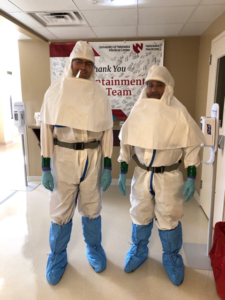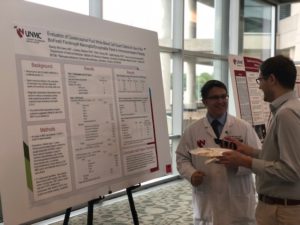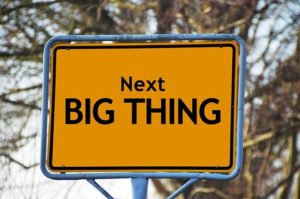 As we get further into the summer, we are yet again nearing West Nile Virus season, and there are starting to be a few cases reported nationwide. Our senior ID fellow Dr. Lindsey Rearigh wrote an article outlining what to expect with West Nile Virus, how it is transmitted, diagnosed, and treated.
As we get further into the summer, we are yet again nearing West Nile Virus season, and there are starting to be a few cases reported nationwide. Our senior ID fellow Dr. Lindsey Rearigh wrote an article outlining what to expect with West Nile Virus, how it is transmitted, diagnosed, and treated.
West Nile Virus (WNV) is a mosquito born illness that made its way to the United States in 1999. The majority of cases are reported in the late summer, peaking from mid- August to September. Although WNV infections have been seen in all the contiguous United States, Nebraska is commonly at the epicenter for cases each year. In fact, Nebraska led the 2018 seasons with 251 total cases reported at the end of the year, including 124 neuroinvasive cases.
In general, birds harbor the virus and transmit the virus to mosquitos after the mosquitos has feed on the infected bird. WNV is most commonly spread to humans by the bite of a mosquito although can rarely be spread through blood transfusions and organ transplantation as well. WNV has not been demonstrated to spread directly from human to human via touch, saliva or other bodily fluids.
Symptoms range from asymptomatic to fevers and neurologic manifestations including meningitis, encephalitis and even flaccid paralysis. About 80% of people affected will be asymptomatic with only about one in 150 cases manifesting as neuroinvasive disease. Symptom onset is seen approximately 2 to 6 days following mosquito exposure, but can be seen up to 2 weeks after a bite in the immunocompromised population. If symptomatic, the elderly are generally more severely affected with a demonstrated increased overall incidence of neuroinvasive disease peaking for those greater than seventy years old.
Diagnosis is typically made via serologic testing for immunoglobulins in the blood. If neuroinvasive disease is suspected cerebral spinal fluid (CSF) should be collected and tested for the immunoglobulins as well. IgM for WNV is usually detectable within 3 to 8 days from illness onset and can stay positive up to 30 to 90 days after initially detected, sometimes longer. IgG for WNV will persist for even longer than IgM even up to years after initially positive, meaning testing positive for IgG alone would not be sufficient evidence to diagnosis an acute infection either in the blood or in the CSF.
Treatment is aimed at symptomatic care with therapies such as high dose steroids and plasmapheresis demonstrating variable improvement in patient outcomes. Time to complete recovery is variable from weeks to months in some cases, and can even leave some permanent neurological affects in the patients most severely affected. There is no vaccination available, so education on prevention is of the utmost importance. Avoidance is key, staying indoors at dawn and dusk when mosquito activity is high and if you are outdoors during those times, wearing long pants and sleeves are recommended. Insect repellant approved by the EPA is also important in efforts to avoid mosquito bites and in general is recommended to be worn over clothing for maximal effect.
Want to find out exactly how many cases of WNV have been reported across the country? Check out the statistics here and here.
The CDC also has a comprehensive resource for more information on WNV.

 Methicillin-resistant Staphyloccous aureus (MRSA) (photo credit: CDC Public Health Image Library) is a bacteria that can cause a wide variety of infections, including skin or soft tissue infections and bloodstream infections (bacteremia). The Centers for Disease Control (CDC) categorize MRSA as a serious threat (1). Although vancomycin has been a reliable antibiotic to treat MRSA for decades, severe infections from it are still difficult to cure. Current MRSA bacteremia practice guidelines by the Infectious Disease Society of America (IDSA) recommend the use of vancomycin or daptomycin as first-line treatment options for bacteremia (2). Concern arises, however, when bacteremia continues despite the use of these agents. IDSA defines persistent MRSA bacteremia as blood cultures that remain positive after 7 days of effective therapy (2). A study conducted by Cosgrove et al found mortality rates as high as 60% from MRSA bacteremia. Changes in therapy or combination therapy may be necessary despite the limited data (3).
Methicillin-resistant Staphyloccous aureus (MRSA) (photo credit: CDC Public Health Image Library) is a bacteria that can cause a wide variety of infections, including skin or soft tissue infections and bloodstream infections (bacteremia). The Centers for Disease Control (CDC) categorize MRSA as a serious threat (1). Although vancomycin has been a reliable antibiotic to treat MRSA for decades, severe infections from it are still difficult to cure. Current MRSA bacteremia practice guidelines by the Infectious Disease Society of America (IDSA) recommend the use of vancomycin or daptomycin as first-line treatment options for bacteremia (2). Concern arises, however, when bacteremia continues despite the use of these agents. IDSA defines persistent MRSA bacteremia as blood cultures that remain positive after 7 days of effective therapy (2). A study conducted by Cosgrove et al found mortality rates as high as 60% from MRSA bacteremia. Changes in therapy or combination therapy may be necessary despite the limited data (3). Dr. Zimmer is also the director of the Oncology ID program, and she completed her ID fellowship at Vanderbilt University, followed by a transplant ID fellowship at Mayo Clinic.
Dr. Zimmer is also the director of the Oncology ID program, and she completed her ID fellowship at Vanderbilt University, followed by a transplant ID fellowship at Mayo Clinic.

 Meet Samantha Cox, a new M1 student in our HIV Enhanced Medical Education Track!
Meet Samantha Cox, a new M1 student in our HIV Enhanced Medical Education Track! There is a clinical effectiveness team at UNMC (including physicians, lab clinicians, pharmacists, nurses and other leaders) at the hospital that looks at things like this to see where we can be more effective at providing high-value, cost conscious care to our hospitalized patients. The GI pathogen panel test is not cheap, and it was being used frequently, so this was a good target for the CE team to tackle. Collaborating with the microbiology lab, we used our hospital electronic health record (EHR) to provide best practice alerts when people tried to order the test, and if someone tried to order it inappropriately (which we designated as >72hrs post admission or duplicate test), there was a hard stop that prevented the test from being signed and completed. If people felt very strongly that the test needed to be done after the hard stop, they could call the microbiology laboratory director to discuss overriding the stop (that did not occur very often).
There is a clinical effectiveness team at UNMC (including physicians, lab clinicians, pharmacists, nurses and other leaders) at the hospital that looks at things like this to see where we can be more effective at providing high-value, cost conscious care to our hospitalized patients. The GI pathogen panel test is not cheap, and it was being used frequently, so this was a good target for the CE team to tackle. Collaborating with the microbiology lab, we used our hospital electronic health record (EHR) to provide best practice alerts when people tried to order the test, and if someone tried to order it inappropriately (which we designated as >72hrs post admission or duplicate test), there was a hard stop that prevented the test from being signed and completed. If people felt very strongly that the test needed to be done after the hard stop, they could call the microbiology laboratory director to discuss overriding the stop (that did not occur very often). When this work was presented at IDWeek2018, many people were looking for simple interventions like this that saved hospitals money, as examples to demonstrate to their C-suites the value of funding Antimicrobial Stewardship. This study is interesting because it shows a relatively simple intervention can have an impactful result. It demonstrates that that when it comes to diarrheal illnesses in the hospital, asking physicians to reconsider if the testing is appropriate through hardwired alerts saves money without compromising quality of care.
When this work was presented at IDWeek2018, many people were looking for simple interventions like this that saved hospitals money, as examples to demonstrate to their C-suites the value of funding Antimicrobial Stewardship. This study is interesting because it shows a relatively simple intervention can have an impactful result. It demonstrates that that when it comes to diarrheal illnesses in the hospital, asking physicians to reconsider if the testing is appropriate through hardwired alerts saves money without compromising quality of care. Another area of interest would be applying this concept to other rapid diagnostic testing. Currently, other available multiplex tests like the GI pathogen panel include the meningitis panel, upper respiratory and newer lower respiratory panel tests; if we can figure out how to use these tests responsibly and not abuse them, we could further improve high-value, high-efficiency and cost-conscious care.
Another area of interest would be applying this concept to other rapid diagnostic testing. Currently, other available multiplex tests like the GI pathogen panel include the meningitis panel, upper respiratory and newer lower respiratory panel tests; if we can figure out how to use these tests responsibly and not abuse them, we could further improve high-value, high-efficiency and cost-conscious care. In 2006, the Centers for Disease Control and Prevention (CDC) recommended universal HIV screening, which was endorsed by the United States Preventive Services Taskforce (USPSTF) in 2013. Despite these recommendations, 1 in 7 persons living with HIV (PLWH) in the United States are unaware of their diagnosis. When stratified by age, young people between the ages of 13-24 account for
In 2006, the Centers for Disease Control and Prevention (CDC) recommended universal HIV screening, which was endorsed by the United States Preventive Services Taskforce (USPSTF) in 2013. Despite these recommendations, 1 in 7 persons living with HIV (PLWH) in the United States are unaware of their diagnosis. When stratified by age, young people between the ages of 13-24 account for  The
The
Recent Comments